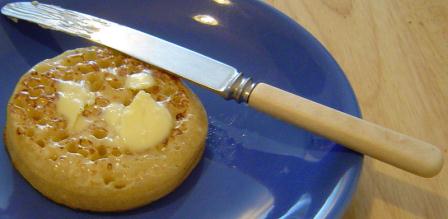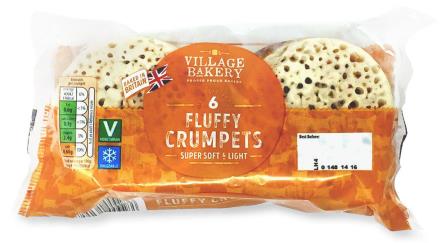

|
 Thick wheatflour batter, very strongly raised with soda or yeast or both, griddle-cooked, usually within a ring, to form a disc, typically 4ins diameter, ¼ins thick (though square forms are very occasionally encountered) of soft breadcake with a flat, slightly browned underside, and an undercooked top with a proliferation of gas holes. Served toasted with butter and preserves. More from Foods of England about Crumpets...  Buttered Crumpet Photo: 'LoopZilla' The name 'crumpet' is known back to the 14th Century (OED), but seems to refer to what we would now call a drop-scone, as in this receipt...  Original Receipt in 'The Cook and Housekeeper's Dictionary' by Mary Eaton (Eaton 1822); Original Receipt in 'The Cook and Housekeeper's Dictionary' by Mary Eaton (Eaton 1822);CRUMPETS. Warm before the fire two pounds of fine flour, with a little salt, and mix it with warm milk and water till it becomes stiff. Work up three eggs with three spoonfuls of thick yeast, and a cupful of warm milk and water; put it to the batter, and beat them well together in a large bowl, with as much milk and water as will make the batter thick. Set it before the fire to rise, and cover it close. Set on the fryingpan, rub it over with a bit of butter tied up in muslin, and pour in as much batter at a time as is sufficient for one crumpet. Let it bake slowly till it comes to a pale yellow; and when cold, the crumpets may be toasted and buttered. But the highly-aerated crumpets of today only became possible after the invention of baking-powder, the first known receipt being...  Original Receipt in The complete confectioner, pastry-cook, and baker, p123, by Eleanor Parkinson. (Lea and Blanchard, 1844); Original Receipt in The complete confectioner, pastry-cook, and baker, p123, by Eleanor Parkinson. (Lea and Blanchard, 1844);Crumpets - Crumpets are made of batter composed of flour, water (or milk), and a small quantity of yeast. To one pound of the best wheaten flour you may add three table-spoonfuls of yeast. A portion of the liquid paste, not too thin (after being suffered to rise), is poured on the heated iron plate, and baked, like pancakes in a pan. * Many persons now make use of the yeast powders, and give them a decided preference. They certainly possess the advantage of requiring less time, and thereby enabling you to make muffins, buckwheat cakes, &.C. - which, set with yeast, require some hours in the preparation - at a quarter of an hour's notice. The ingredients are the super-carbonate of soda and tartaric acid, to be used in the following manner:- A spoonful of soda, and a spoon two-thirds full of tartaric acid, are to be dissolved separately in a little water. The soda is to be put into the batter when it is partly beaten, taking care that it is perfectly dissolved; and the acid is to be added when the cook is ready to begin baking, as they must not be allowed to stand after the effervescence takes place.  Aldi, 2020  |
|
MORE FROM Foods of England... Cookbooks ● Diary ● Index ● Magic Menu ● Random ● Really English? ● Timeline ● Donate ● English Service ● Food Map of England ● Lost Foods ● Accompaniments ● Biscuits ● Breads ● Cakes and Scones ● Cheeses ● Classic Meals ● Curry Dishes ● Dairy ● Drinks ● Egg Dishes ● Fish ● Fruit ● Fruits & Vegetables ● Game & Offal ● Meat & Meat Dishes ● Pastries and Pies ● Pot Meals ● Poultry ● Preserves & Jams ● Puddings & Sweets ● Sauces and Spicery ● Sausages ● Scones ● Soups ● Sweets and Toffee ● About ... ● Bookshop ● Email: [email protected] COPYRIGHT and ALL RIGHTS RESERVED: © Glyn Hughes 2022 BUILT WITH WHIMBERRY |